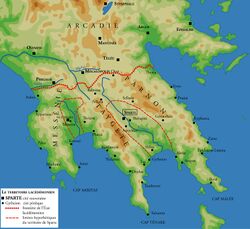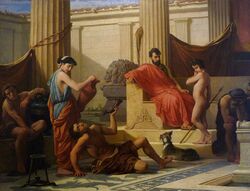What was the Spartan Training called the Agoge
The idea of ancient Spartan heroism has been depicted so often in modern fiction that scholars have coined the term “Spartan Mirage” to refer to what they see as an exaggerated idealization of ancient Spartan culture that borders on mythologization. Films such as 300 routinely show the Spartans as the best trained, bravest, and most capable of all the Greeks, and for the most part, until the Spartans lost in the Battle of Leuctra in 371 BC, that idea was not far from reality. Despite being outnumbered, the Spartans usually won the day and were vital to the Hellenic League’s victory in the Persian Wars (499-479 BC). The secret behind the Spartans’ martial success was their unique form of education known as the agoge.
The agoge was the extreme form of education that all Spartan boys embarked on at the age of seven and continued until they reached thirty or died. Along with physical education and standard academic curriculum, the agoge was critical to teach boys how to think and act like proper Spartans who would be willing at any time to die for the state. The agoge taught Spartan boys the values of conformity and unity, courage, patriotism, martial prowess, guile, and brutality. Once Spartan boys completed their training in the agoge, they had to serve the state in all military campaigns but were also free to marry, start families, and own land.
A Utilitarian Society
To understand what the agoge was and its importance to ancient Spartan society, one must first understand the nature of a society that would create such an institution. Ancient historians believed that Sparta evolved from a standard Greek city-state into the militaristic state for which it became known took place under the direction of the legendary lawgiver, Lycurgus, sometime in the ninth or eighth century BC.
Although modern historians do not necessarily deny Lycurgus's existence, most believe that Sparta’s transformation into a military state gradually took place over a long period but was probably stimulated by the Second Messenian War (650-620 BC). [1]
Many classical authors wrote about the infamous Spartan lifestyle and ideology, with few more detailed than the first century BC Greek biographer, Plutarch. In his Lives, Plutarch compared and contrasted several Spartan leaders, including Lycurgus, with other Greek and Roman leaders. Plutarch painted a picture of life in classical Sparta as very austere. The men ate communally, a form of iron currency replaced gold and silver coins, and the land was distributed equally among the male citizens, known as Spartiates. [2] The practices were meant to reinforce the idea that all Spartiates were equals and foster a sense of unity among the men. The policies were certainly unique among the Greek city-states, but they were not the only types of social engineering the Spartans practiced that separated them from the other Greeks.
The Spartans viewed sex, marriage, and procreation in a very antiseptic, utilitarian fashion, much as they did everything. Spartan men forcefully “captured” Spartan women in their prime, beginning a long courting and marriage process that would only result in cohabitation much later in the relationship. “Love” in the modern sense of the word was probably one of the last factors that determined the pairings of Spartan couples or the duration of their relationships; men who were past their sexual and/or physical prime were said to encourage their wives to have relationships with younger men to produce more Spartan children. [3]
There is little doubt that the entire purpose of marriage and procreation in Sparta was to produce boys who would become warriors for the city’s vaunted army or girls who would give birth to warriors. According to Plutarch, the Spartan state engaged in an early eugenics program.
“First and foremost, Lycurgus considered children to belong not privately to their fathers, but jointly to the city, so that he wanted citizens produced not from random partners, but the best.” [4]
To entice Spartan men to have many children, especially males, Spartiates who produced three sons were exempt from the constant and often onerous military service, and those with four sons were exempt from taxes. On the other hand, there were penalties against bachelorhood, which left a few Spartan men unmarried and without children. [5]
The Spartans’ unique attitude towards marriage and procreation was built upon the philosophy that the state was supreme and attained that supremacy through warfare. All Spartiates were full-time soldiers, so to feed themselves, they enslaved neighboring Greeks known as Helots. Although the Helots numbered as many as 150,000 to the five to eight thousand Spartiates, a combination of the Spartans' training and a system of brutal repression kept revolts to a minimum. [6] Once Spartan children were born, the training immediately began that reinforced the Spartan social system.
Small and disabled children were exposed to the elements, and infants were hardened physically and mentally by not being given swaddling clothes and being left alone to cry, among other toughening tactics. [7] According to Plutarch, even Spartan girls were given a crash course education in physical training.
“Lycurgus, rather, showed all possible concern for them too. First, he toughened the girls physically by making them run and wrestle and throw the discus and javelin.” [8]
As physically strong as Spartan girls may have been, the most rigorous physical and mental training was reserved for boys beginning at age seven.
The Agoge
When Spartan boys reached seven, they were taken from their families and forced to live communally with other boys their age while they were educated in the agoge. Although the agoge included traditional classes on writing and rhetoric, its emphasis was clearly on combat, physical fitness, and violence in general. For the first few years of their training, the boys were given older mentors and introduced to a life of austerity, but when they reached the age of twelve, the training really began.
Once boys in the agoge reached twelve, they were only allowed to possess one cloak per year and were not allowed to use bathing oils. Although these restrictions may not seem very severe, they were meant to prepare the boys for their training's much more brutal aspects. Along with courage and physical prowess, guile was valued as one of the most important traits a Spartan warrior could possess. Boys in the agoge were taught to steal to survive.
“They steal what they fetch, some of them entering gardens, others slipping into the men’s messes with a fine mixture of cunning and caution. If a boy is caught, he receives many lashes of the whip for proving to be a clumsy, unskilled thief. The boys also steal whatever provisions they can, thereby learning how to pounce skillfully upon those who are asleep or keeping guard carelessly. A boy is beaten and goes hungry if he is caught.” [9]
The punishments the boys suffered were not due to them being thieves, though, but was instead because they were caught. Spartan boys were subjected to a constant barrage of physical and mental brutality determined to weed out the week and strengthen those who survived. The mentors and older boys regularly instigated brawls between the young boys in the agoge.
“Moreover as they exercised boys were constantly watched by their elders, who were always spurring them on to fight and contend with one another: in this, their chief object was to get to know each boy’s character, in particular, how bold he was, and how far he was likely to stand his ground in combat.” [10]
Injuries were probably quite common in the agoge, and death also came with the territory. Plutarch claimed that many Spartan boys died from “the lashes they received at the altar of Artemis Orthia.” [11]
Setting the Tone for Spartan Society
In summary, the agoge can be described as ancient Sparta’s ruthless educational system for boys. Still, it was so much more than that as it provided the backbone of Spartan society. Once the boys learned the proper fighting techniques, and more importantly, the ideas of austerity, unity, patriotism, courage, and guile, they would begin transitioning out of the school at about twenty.
When most boys reached twenty, they would meet members of their future syssitia – messmates and those they fought alongside – whom they would officially join at the age of thirty. [12] The agoge gradually declined in importance as the Spartans’ numbers declined, but it was briefly revived under Cleomenes III (ruled 235-222 BC), who perhaps somewhat ironically began accepting Helots into the school and eventually as full Spartiates. [13]
Conclusion
Today, the ancient Spartans are rightfully viewed as the most accomplished warriors in the early Hellenic world and among the greatest in the entire period of ancient history. For about 300 years, the Spartans dominated their neighbors through a combination of superior military tactics, bravery, and sheer brutality; but that dominance did not take place overnight.
The educational system known as the agoge taught Spartan boys military tactics and bravery, but more importantly, it instilled in them proper Spartan values. The values taught in the agoge permeated all aspects of Spartan society, so it is not surprising that when the agoge diminished in importance, so did Sparta’s power in the Hellenic world.
References
- ↑ Knottnerus, J. David, and Phyllis E. Berry. “Spartan Society: Structural Ritualization in an Ancient Social System.” Humboldt Journal of Social Relations 27 (2002) p. 2
- ↑ Plutarch. On Sparta. Translated by Richard J. A. Talbert. (London: Penguin Books, 2004), Lycurgus, VII-VIII
- ↑ Scott, Andrew G. “Plural Marriage and the Spartan State.” Historia: Zeitschrift für Alte Geschichte 60 (2011) p. 419
- ↑ Plutarch, Lycurgus, XV
- ↑ Scott, p. 421; 416
- ↑ Knottnerus and Berry, p. 4
- ↑ Plutarch, Lycurgus, XVI
- ↑ Plutarch, Lycurgus, XIV
- ↑ Plutarch, Lycurgus, XVII
- ↑ Plutarch, Lycurgus, XVIII
- ↑ Ibid.
- ↑ Knotterus and Berry, p. 20
- ↑ Cawkwell, G. L. “The Decline of Sparta.” Classical Quarterly 33 (1983) p. 392


